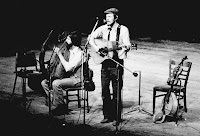
SOME BACKGROUND ON CONTEMPORARY CELTIC MUSIC
Caswell-Carnahan © 1981
 The term 'Celtic Music’ covers the many traditional musical forms born and developed in Scotland, Ireland, Wales, Brittany and the far-flung islands of the North Sea. In ancient times, instrumentation began with flutes, early harps, drums and voices. One by one, new instruments were invented or introduced into the Celtic world. Bagpipes sprang up in many places in Europe. New styles of song and dance were brought in by Viking invaders, traders from the Continent and shipwrecked survivours of the Spanish Armada. Fiddles of Italian design found their way north. The craft of designing and perfecting musical instruments thrived throughout the British Isles, to produce hauntingly different pipes and harps, whistles and drums. And the Celtic tongues, which changed and grew, still retained the ancient bardic power of languages needing no written form to express their wisdom and beauty.
The term 'Celtic Music’ covers the many traditional musical forms born and developed in Scotland, Ireland, Wales, Brittany and the far-flung islands of the North Sea. In ancient times, instrumentation began with flutes, early harps, drums and voices. One by one, new instruments were invented or introduced into the Celtic world. Bagpipes sprang up in many places in Europe. New styles of song and dance were brought in by Viking invaders, traders from the Continent and shipwrecked survivours of the Spanish Armada. Fiddles of Italian design found their way north. The craft of designing and perfecting musical instruments thrived throughout the British Isles, to produce hauntingly different pipes and harps, whistles and drums. And the Celtic tongues, which changed and grew, still retained the ancient bardic power of languages needing no written form to express their wisdom and beauty.Time widened the scope of the bardic tradition. The 18th Century harper O'Carolan popularized the Celtic harp as never before, becoming the Mozart of the Irish gentry. During dark times when playing the bagpipes was punishable by death, enterprising pipers developed the soft and sweet uilleann and border pipes, which could be played inside, out of the soldiers’ hearing. And up to the present day the Scots, Irish and Welsh demonstrate an incredible flair for songwriting, eloquently expressing their strong emotions, their fierce national pride and their ancient history.
What we call 'Contemporary Celtic Music' represents a new growth from traditional roots. In Ireland, the experimentation began in the '50s when Sean O'Riada and Sean O'Se (pronounced O'Shay) tried arranging airs, jigs and reels in classicized orchestrations, working in harpsichords and strings. They altered tempos and switched around themes, opening the door to new, wider experimentation by an eager generation of musicians. This new twist was popularized by groups like the Chieftains, and young performers began to write new material, new tunes to well-known ballads, new poetry to ancient airs. A Galway singer brought a bouzouki to Ireland in 1966 and exotic rhythmic instruments become standard fare all over the British Isles almost overnight. Guitarists, once excluded by traditional “purists”,created tremendously skilled settings for many traditional pieces. Instrumental combination was up for grabs. Freely borrowing from the popular influences of jazz and rock, renaissance and medieval, and traditional forms of Europe, Asia and the Middle East, groups like Planxty in Ireland and the Battlefield Band in Scotland have fused styles as seemingly divergent as Irish and Bulgarian dances. Artists like Alan Stivell in Brittany have added Celtic harp and bagpipes to full-blown rock bands. This experimentation continues, providing a fresh and widening appeal to musical forms with roots over 2000 years old. And, happily, these new experiments have not overwhelmed the traditional forms. The traditional music of the Celtic world continues stronger than ever, providing limitless source material for today's Contemporary Celtic movement.










No comments:
Post a Comment